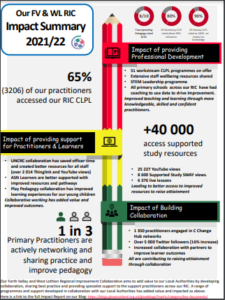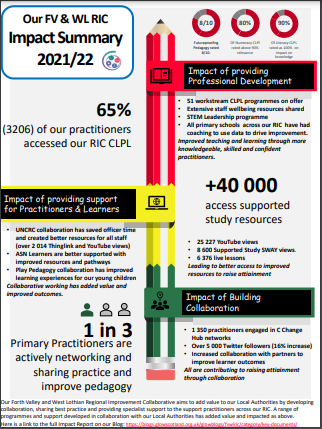 Why is this being prioritised?
Why is this being prioritised?
The data from the four regions indicates that there is a significant issue with Numeracy, particularly between first and second level. This is reflected in the 2015/16 and 2016/17 teacher Professional Judgement Survey for all four authorities.
Overarching Aims
• To reduce the percentage gap from Early to First Level in Numeracy.
• To use and enhance the expertise and talent within the Forth Valley and West Lothian RIC to develop collaborative learning approaches which build staff capacity to deliver high quality learning experiences in First Level Numeracy.
What do we want to achieve?
To establish an inter-authority, teacher driven, professional network that will work together to strengthen and improve confidence and understanding in teaching numeracy. The focus will initially be at CfE 1st level.
To further develop the partnership between the four Numeracy hub champions where they will jointly design and deliver high quality CLPL to identified schools and classroom practitioners.
Actions and Indicators of Progress
Short term (February-June 2018)
1. Identify leads from each authority (Numeracy Team) to work with the numeracy champions to develop a plan based on feedback from teachers and practitioners
2. Analyse baseline data and information from across the RIC
3. Identify common areas for targeting interventions
4. Identify drivers for improvement (Numeracy Strategic Plan Appendix 1)
5. Identify up to 3 schools to participate in a pilot project aimed at building staff capacity within First Level Numeracy
6. Develop a professional learning programme to support the pilot project (to be delivered by numeracy champions)
7. Produce a contract for each school engaged with the project to agree parameters commitment, and feedback outcomes to the wider RIC
Medium term (August 2018- June 2019)
1. Undertake pilot project- Numeracy PL programme
2. Gather feedback from head teachers and teachers about the pilot project, and review against agreed outcome criteria (discussed with RIC lead group)
3. Revise and prepare roll out of the CLPL programme to a wider audience throughout the RIC
4. Numeracy Hub Champions will facilitate professional dialogue on a monthly basis to increase teacher confidence in using manipulatives to help children and young people gain a deeper understanding of mathematical concepts
5. An agreed assessment measure using teachers’ professional judgement will be used to gauge progress over time
6. The Numeracy Team will discuss measurement of progress and analysis of data with the Performance Improvement Team
7. Create a Numeracy data pack demonstrating tracking progress and improvement
8. Engage with the Communications Team to design a strategy to share practice and develop a practitioner network for numeracy
9. Provide input to the Autumn FV & WL RIC Consultation on the ‘Ask and the Offer’
10. Review Numeracy plans in light of the outcomes of the consultation
Longer term
1. Evaluate the effectiveness of staff development approaches
2. Numeracy Hub Champions will establish an electronic platform for staff involved to engage in professional dialogue and share good practice
3. Review progress at 1st level Numeracy and reducing the gap from early to 1st level using data analysis, and discuss next steps in preparing to progress into 2nd level
4. The Numeracy team will explore and facilitate sharing best practice from PEF strategies across the RIC
5. A wider collaboration strategy will be developed with partners and stakeholders including CLD, H&WB groups and parents
Intended Impact of the Numeracy Plan
The measures of success will be:
- Teacher feedback demonstrates improved engagement and confidence in numeracy delivery
- Take up and evaluative feedback of collaborative CLPL opportunities and models of collaboration
- Participation by class teachers and regional network input
- Engagement and participation with the digital communication platform
- Numeracy at 1st level shows improvement in teacher professional judgement surveys
- CfE 1st level increases across the RIC
- The gap between early and first level is reduced for children from the lowest quintile and highest








